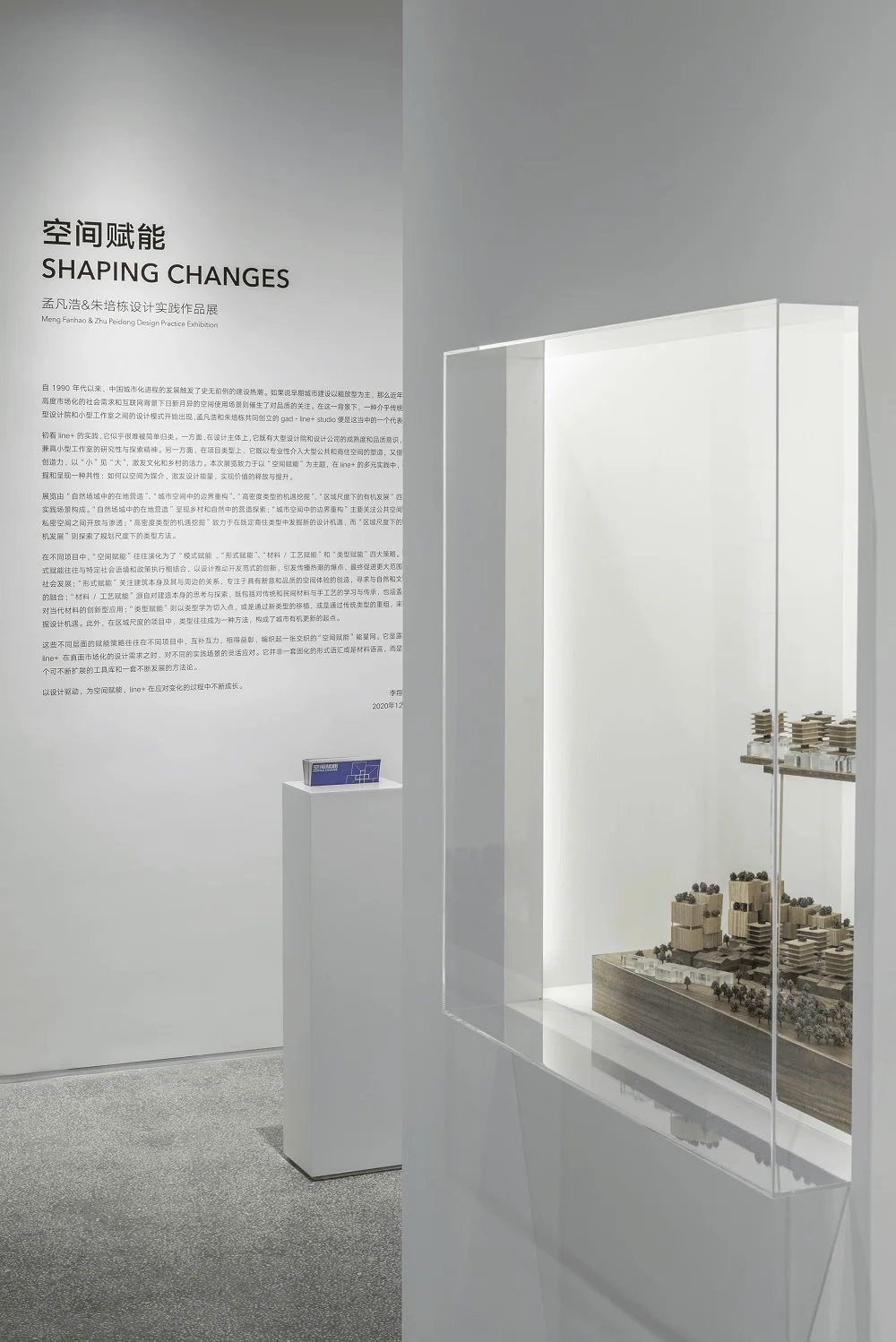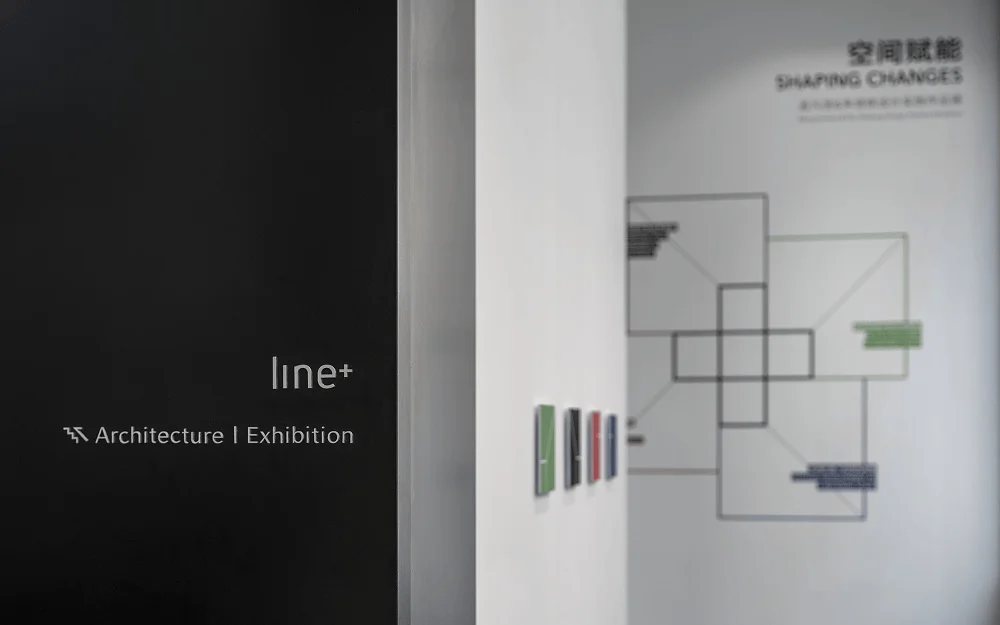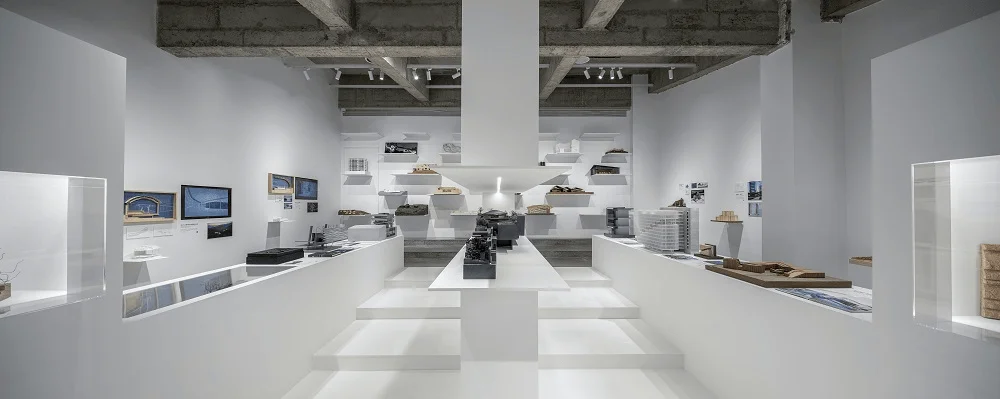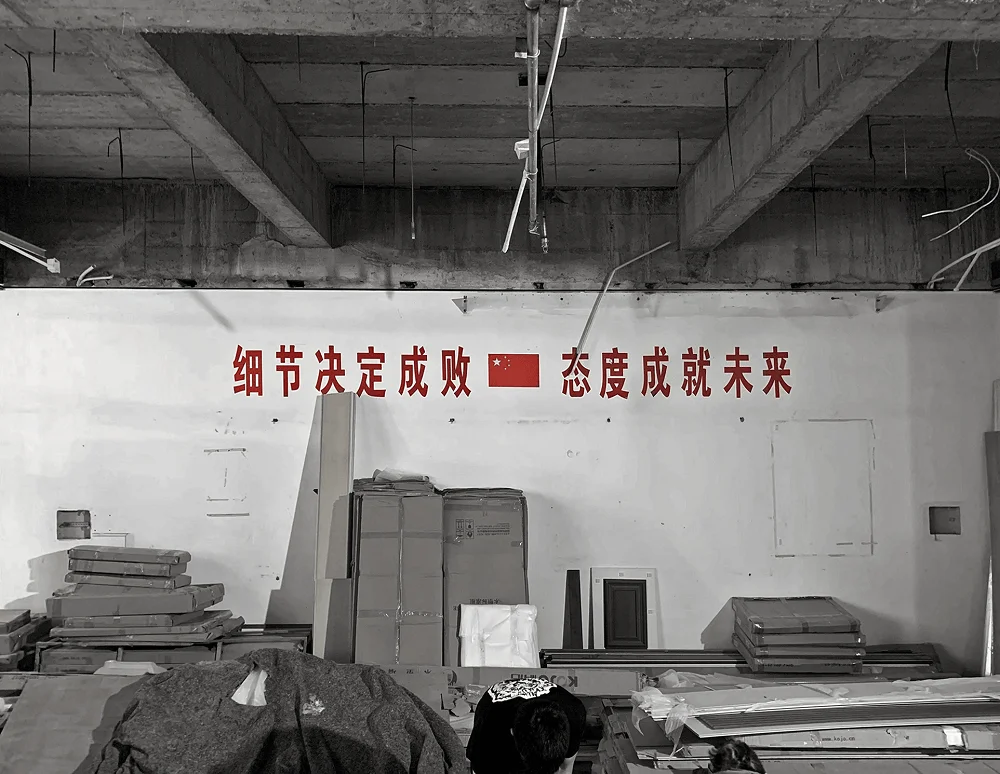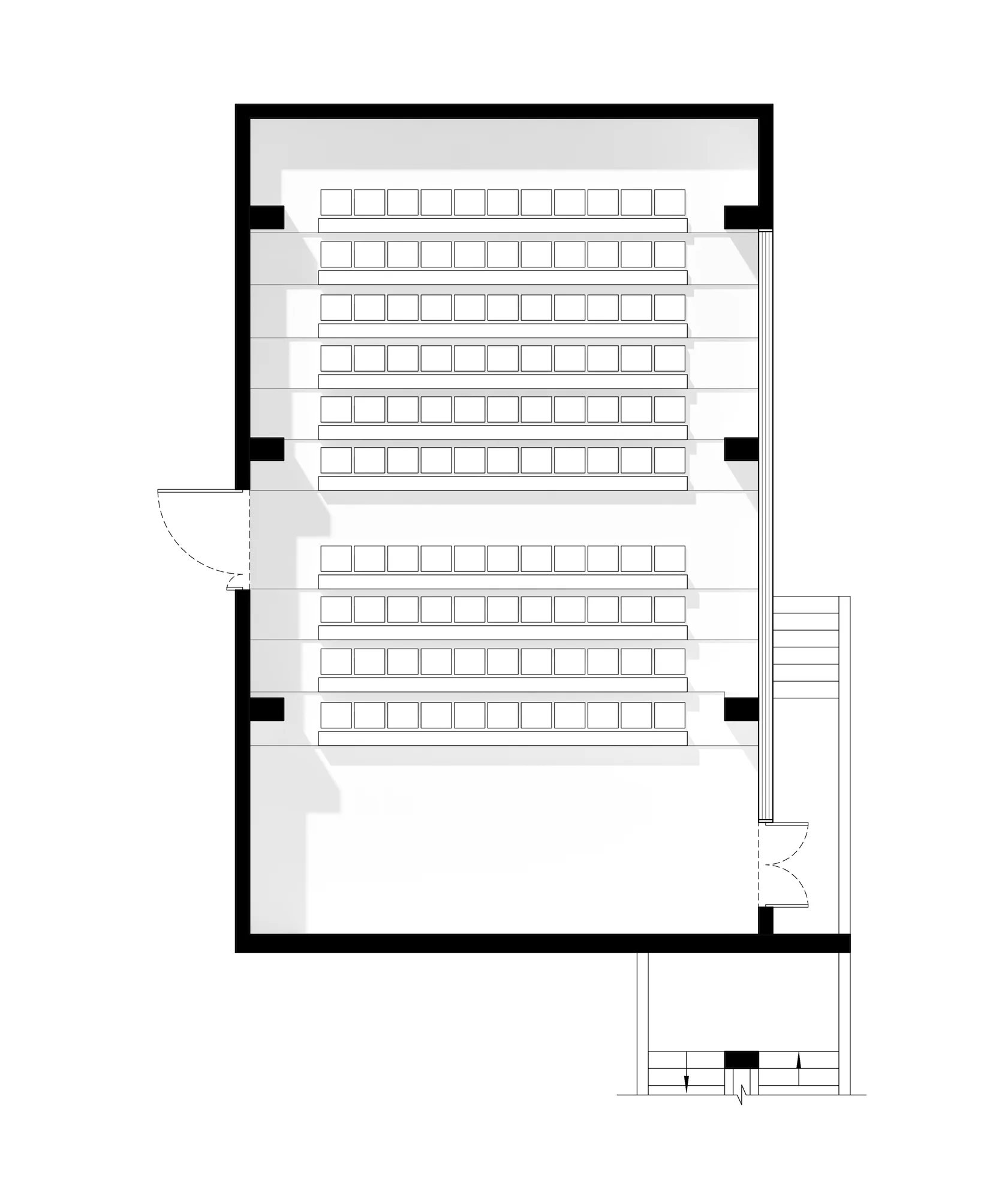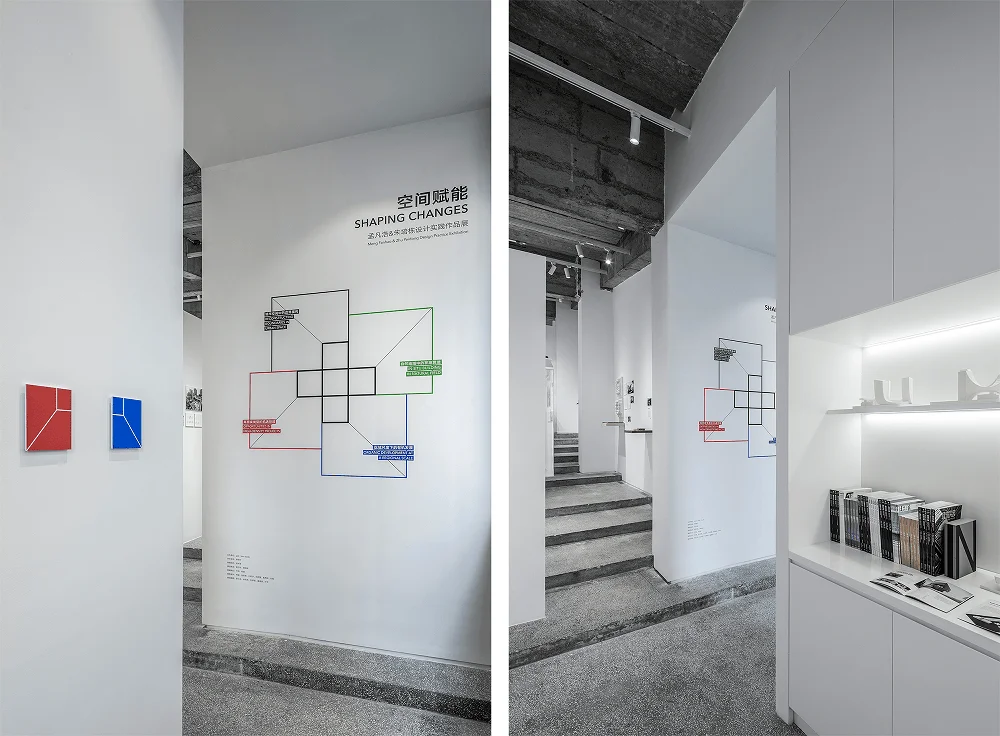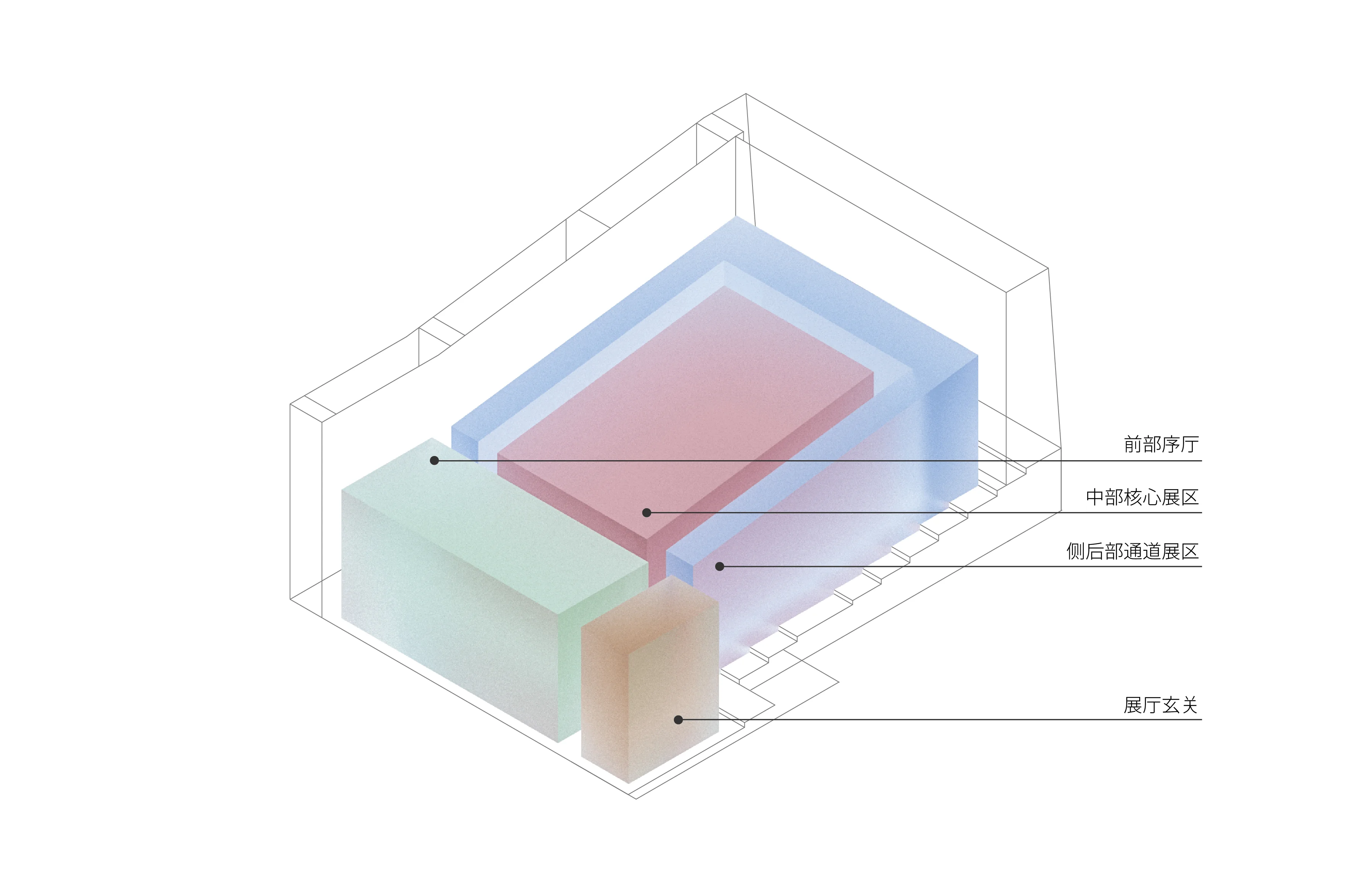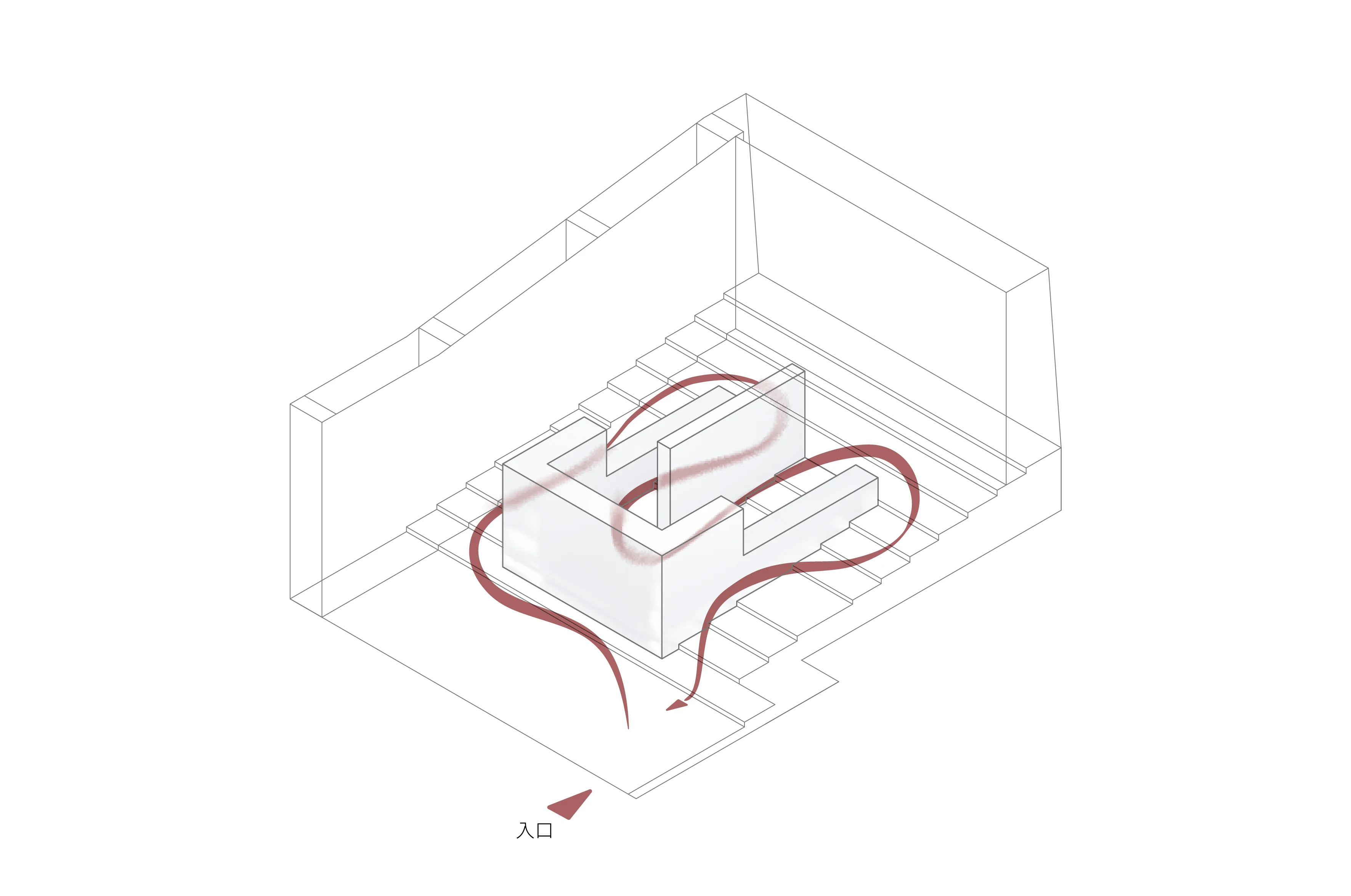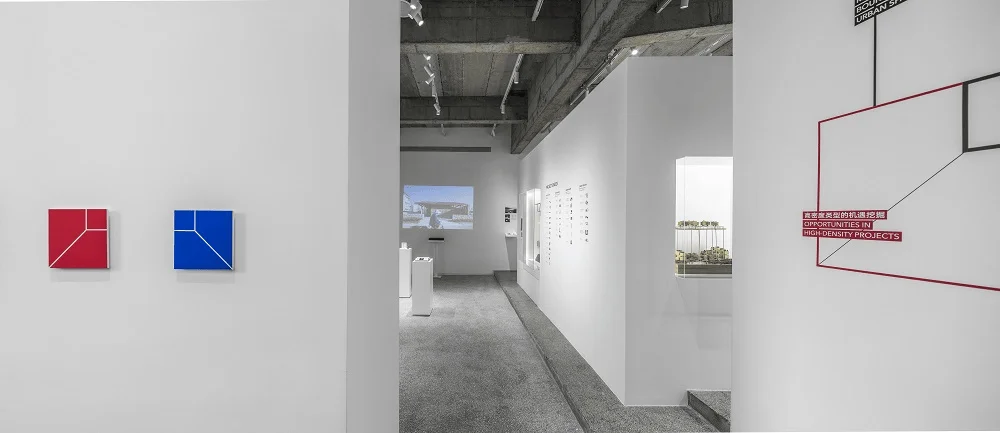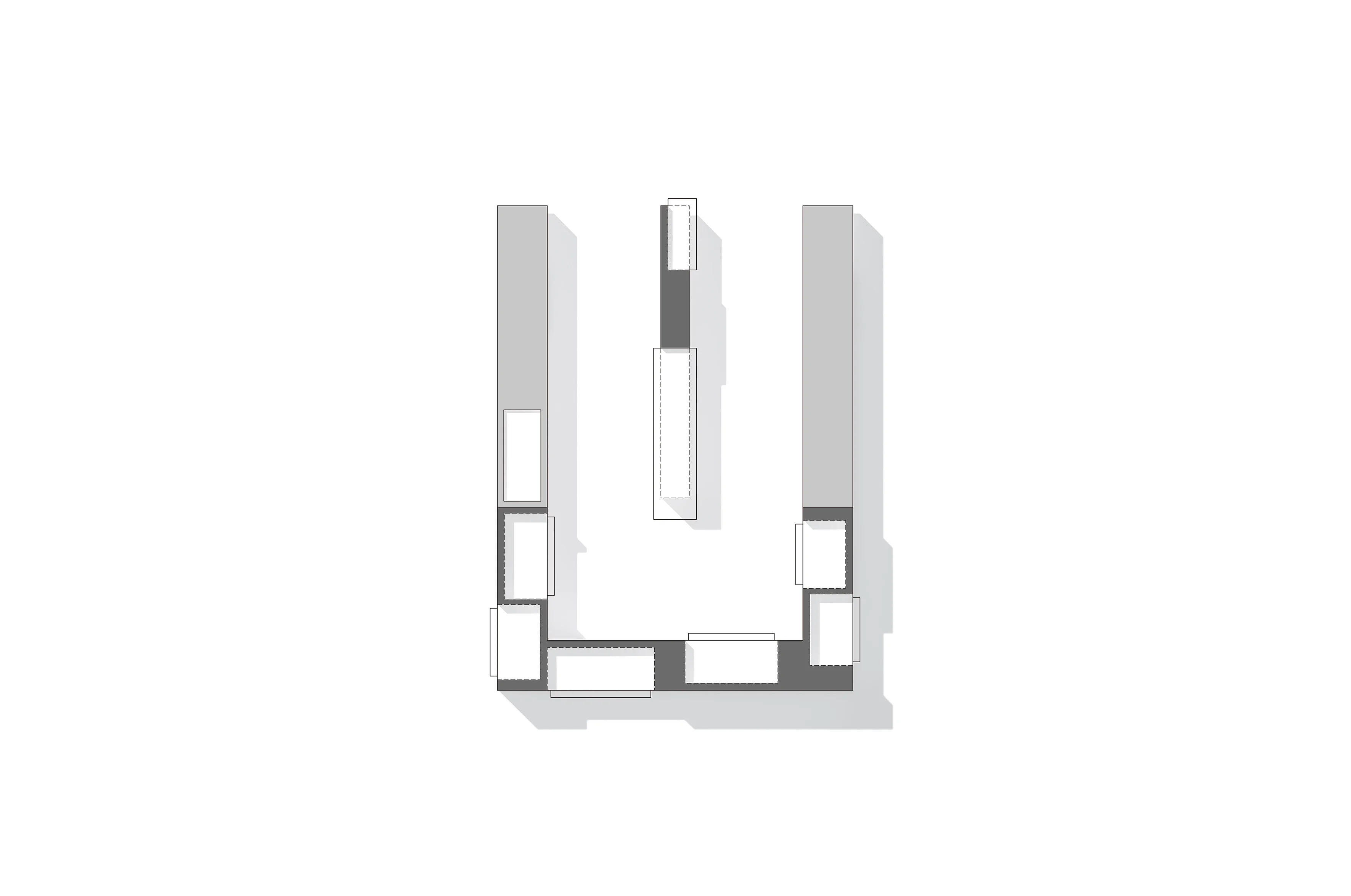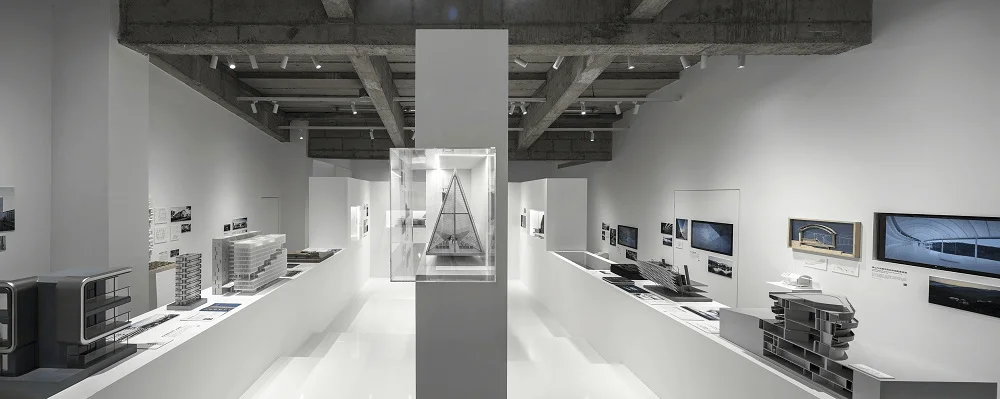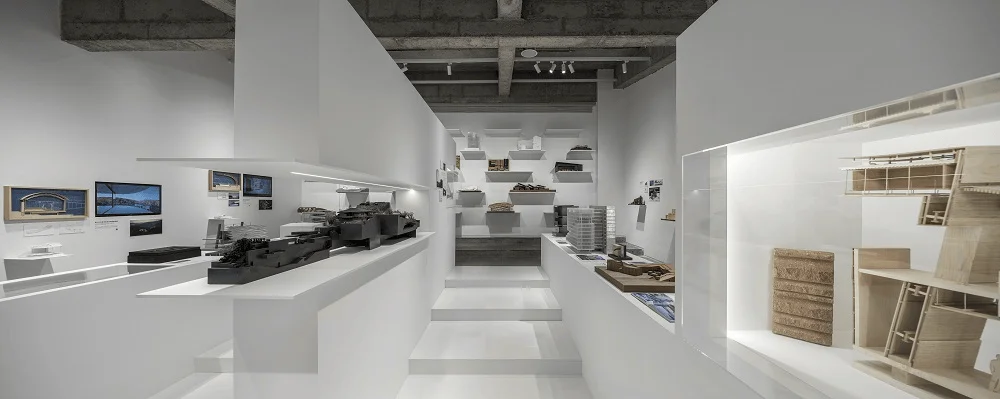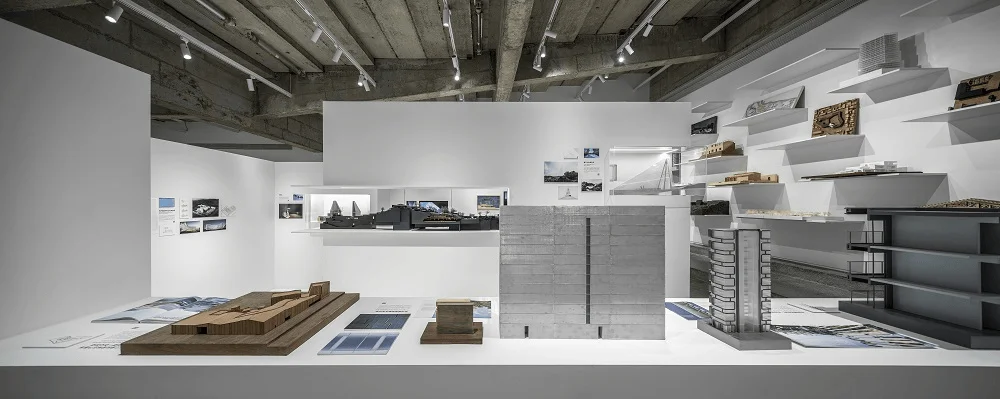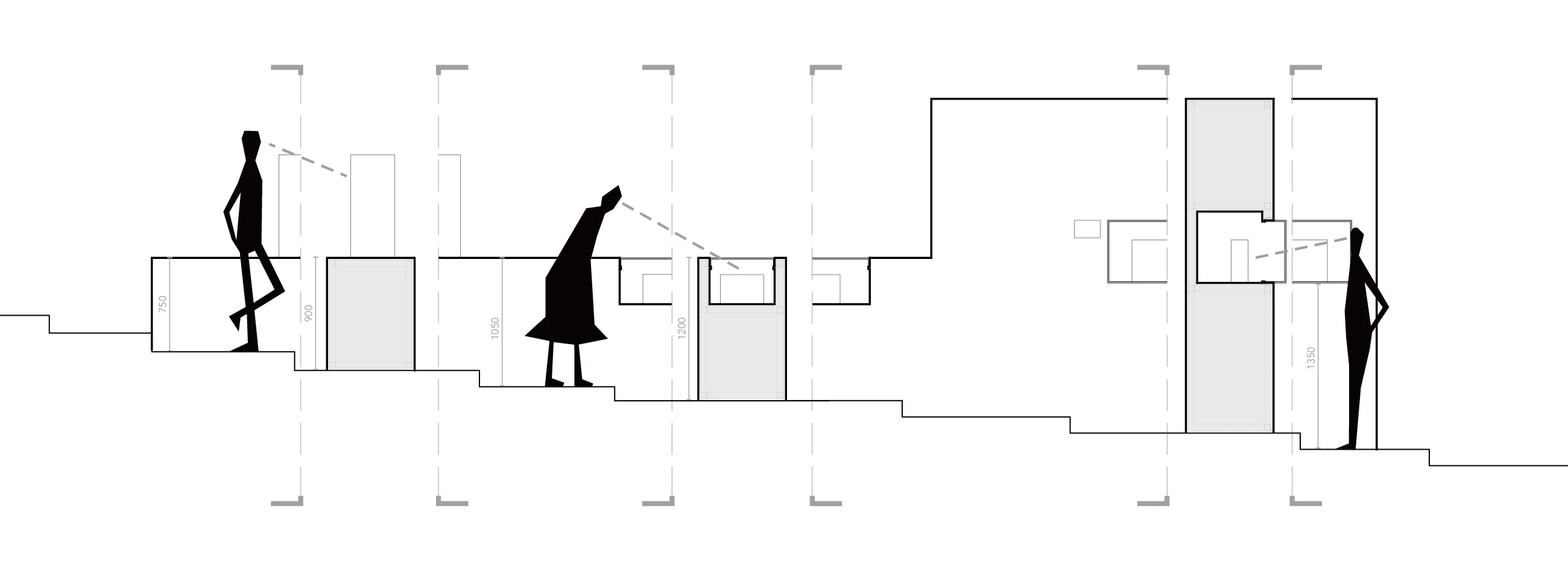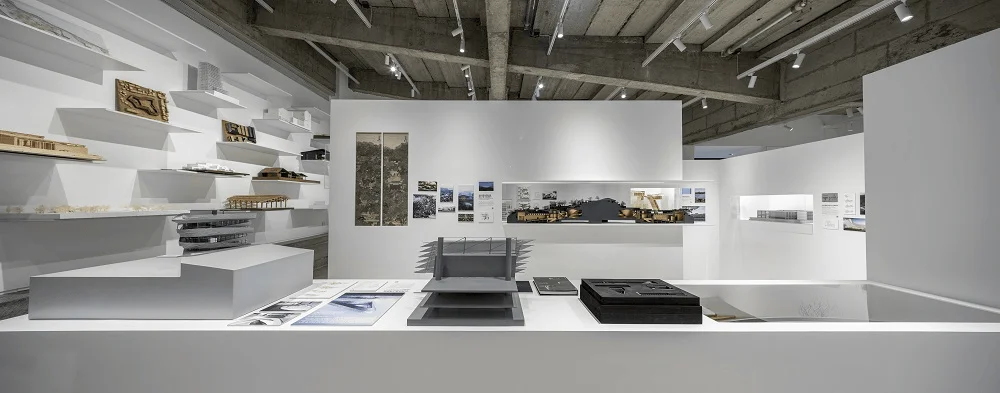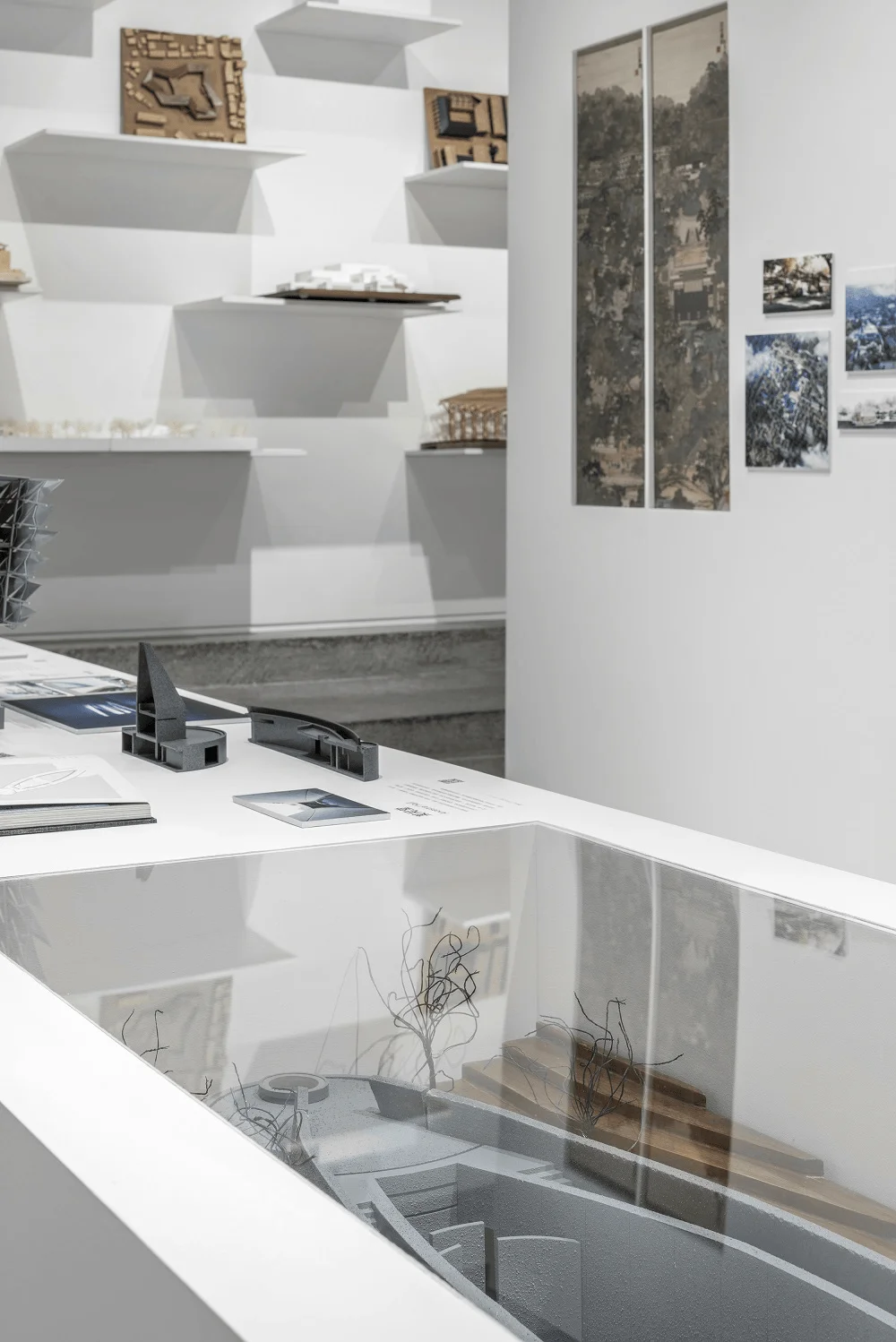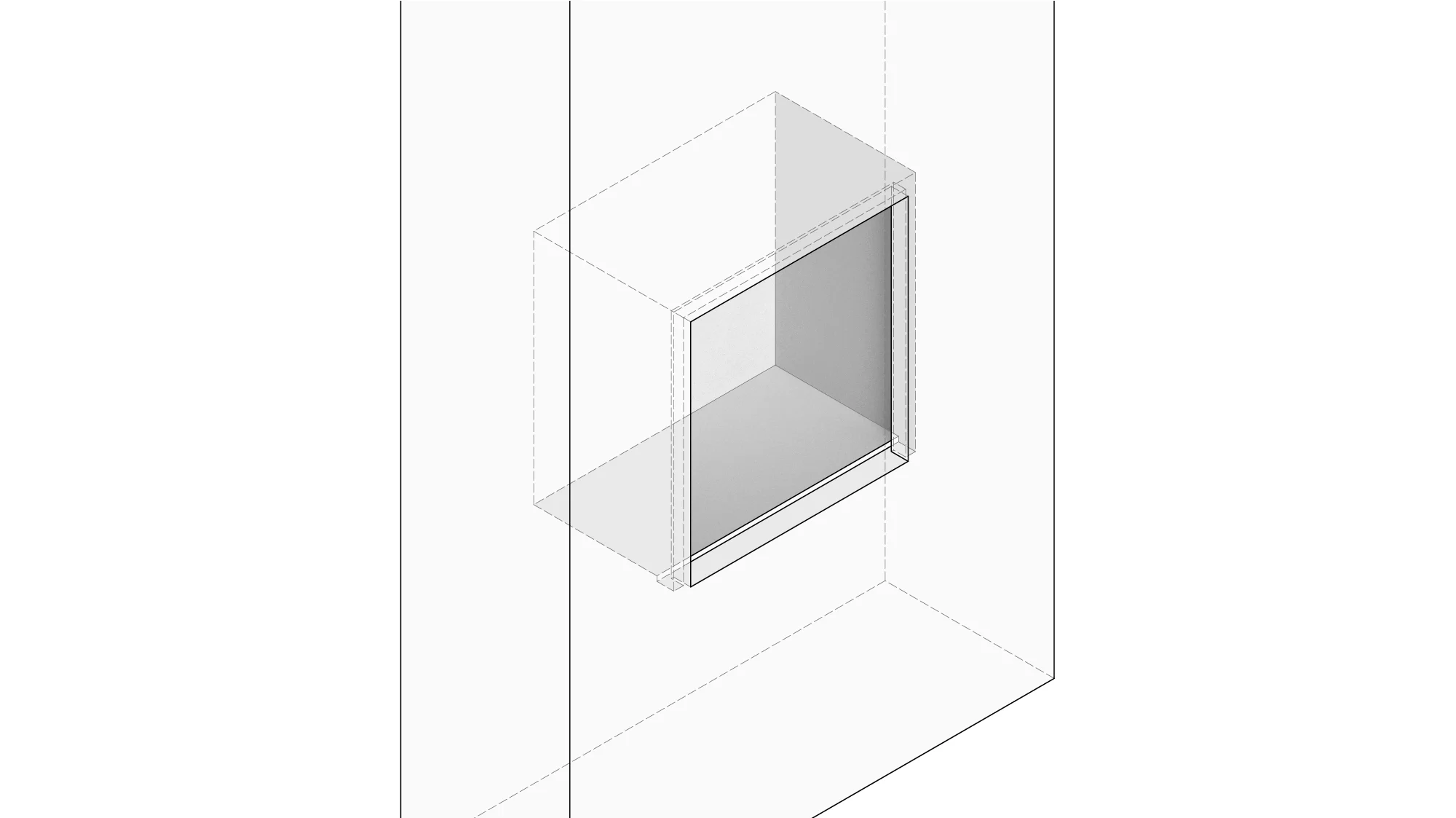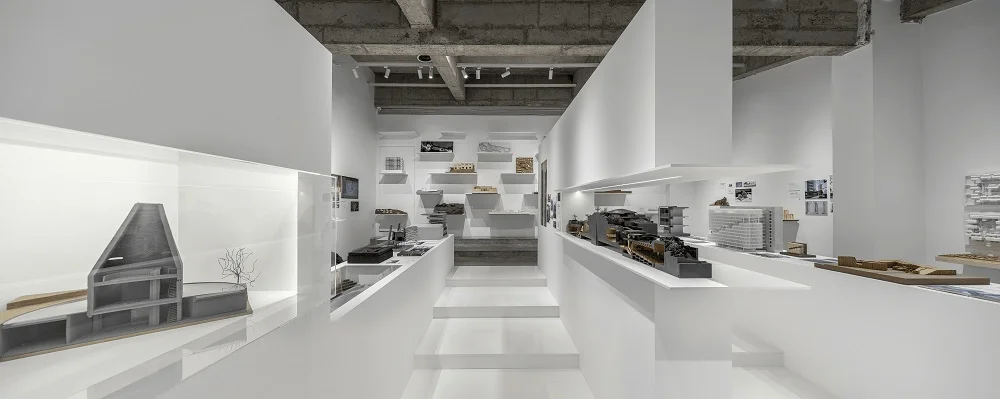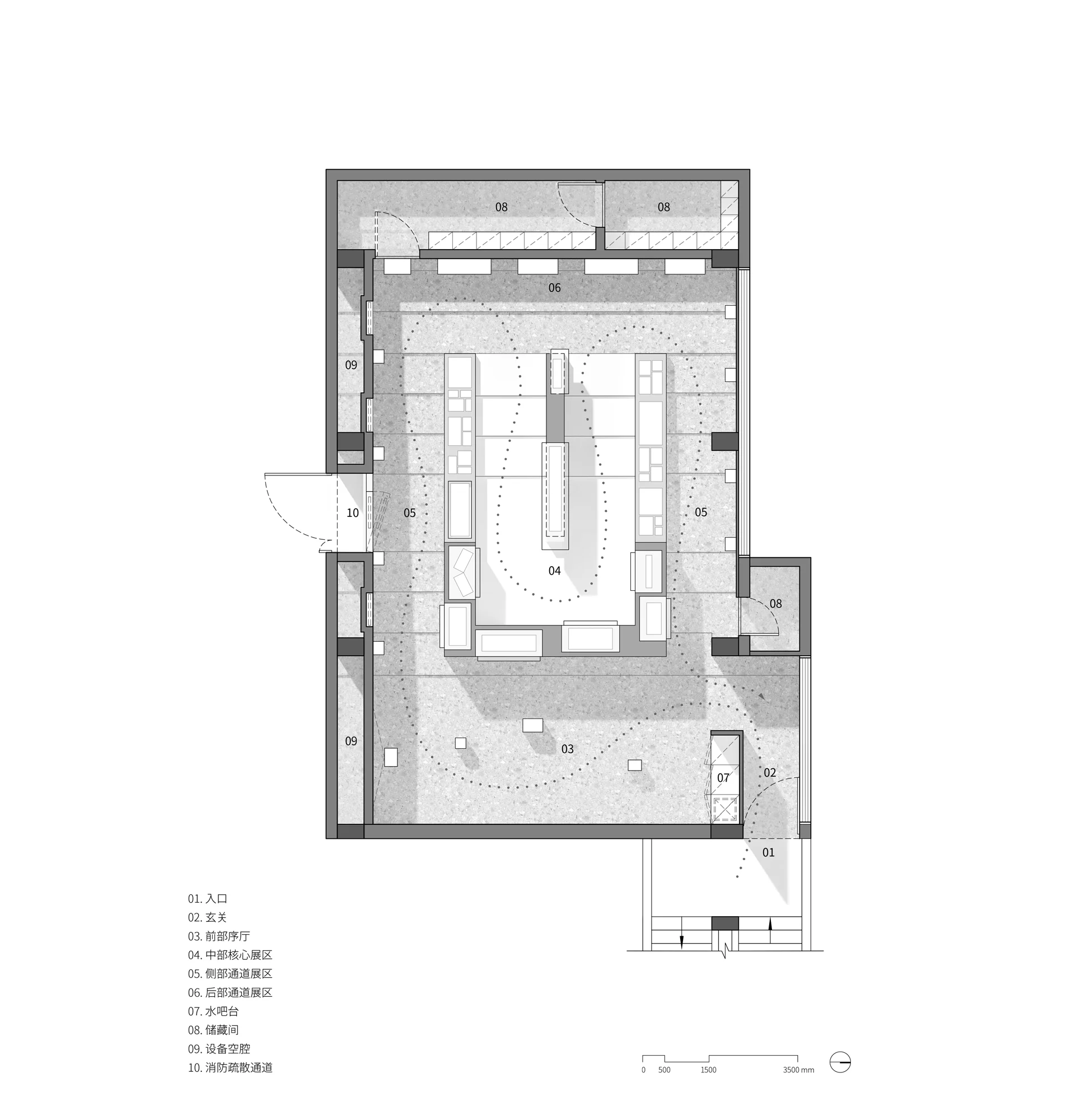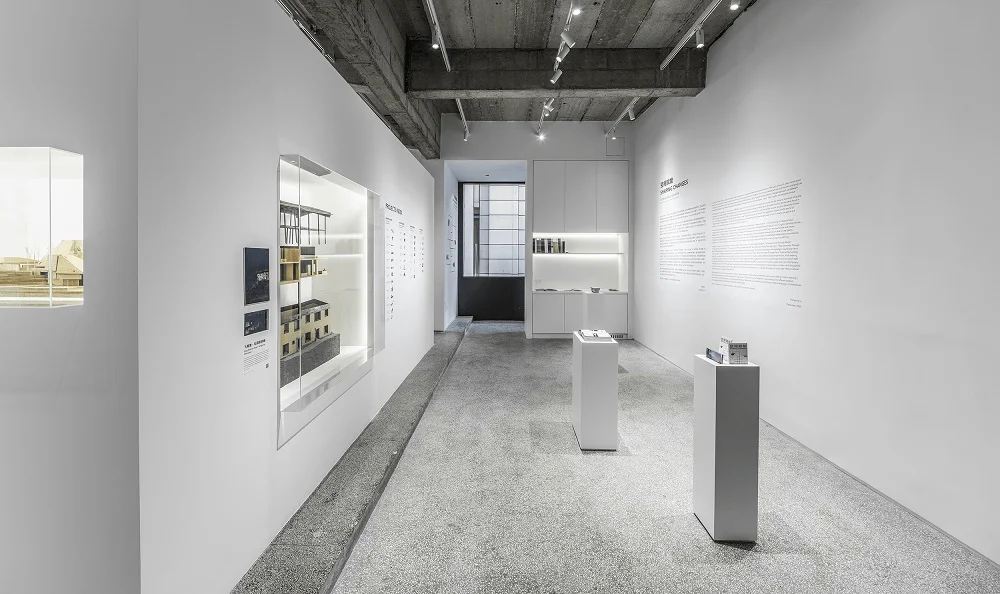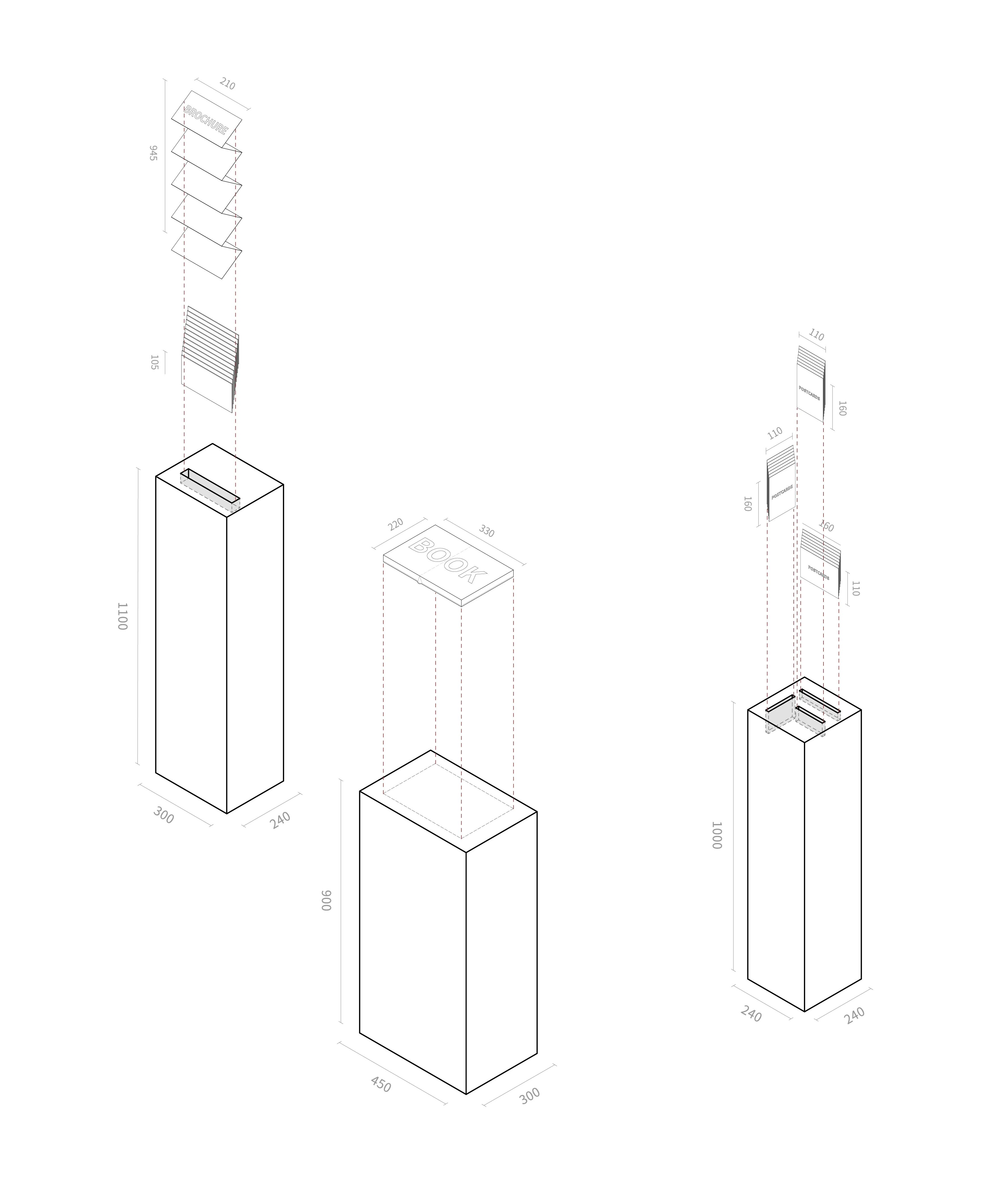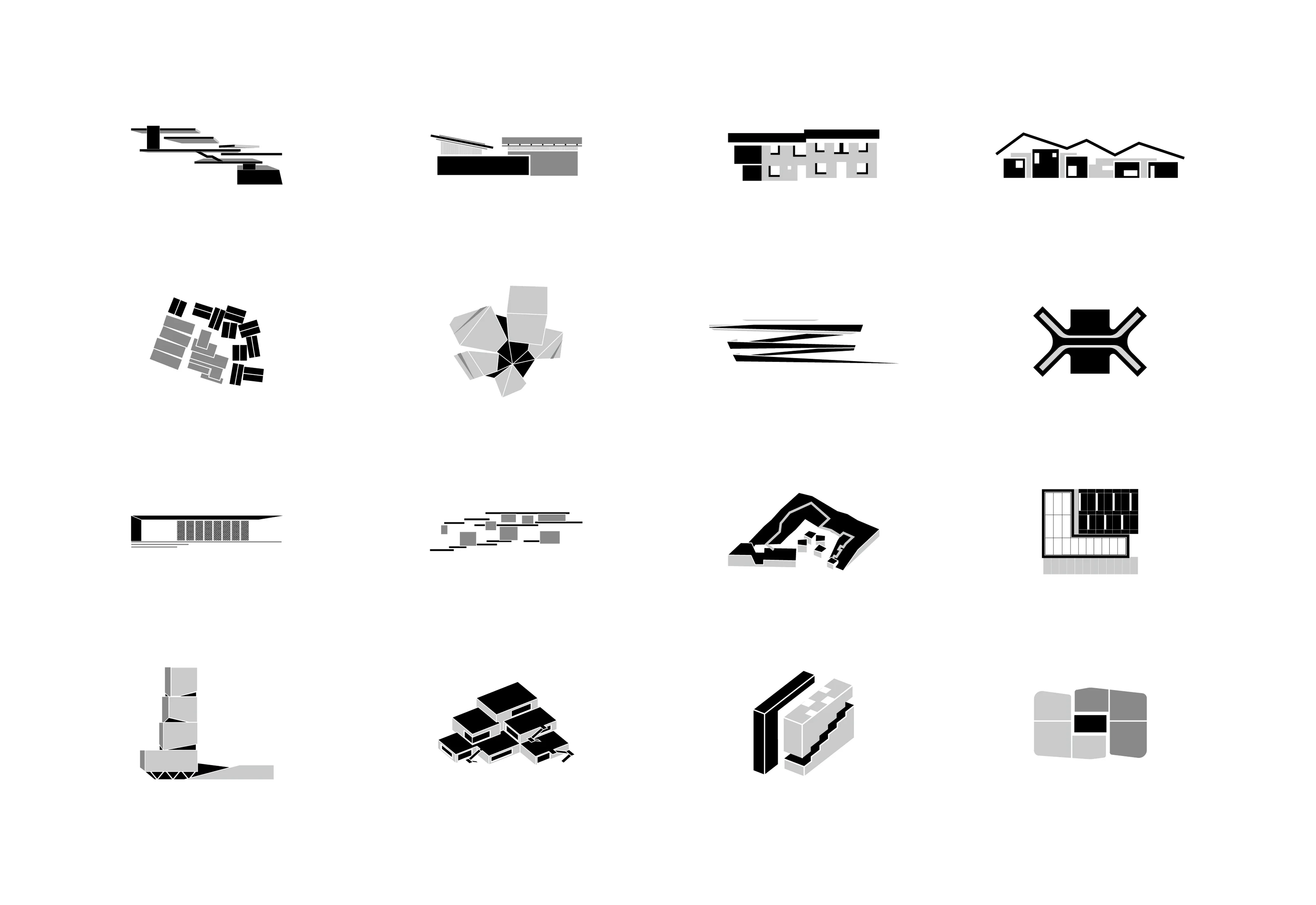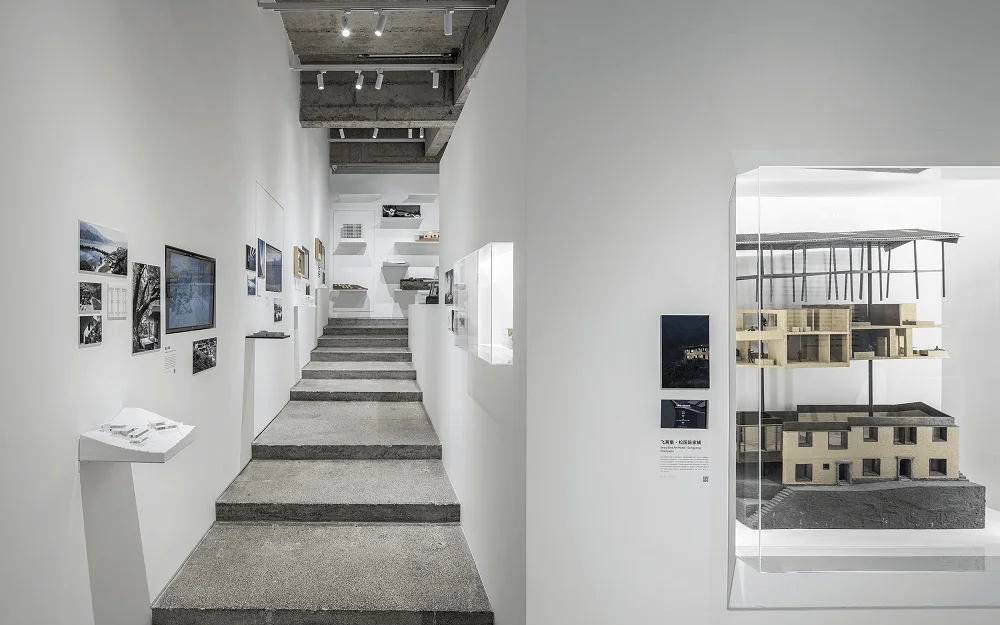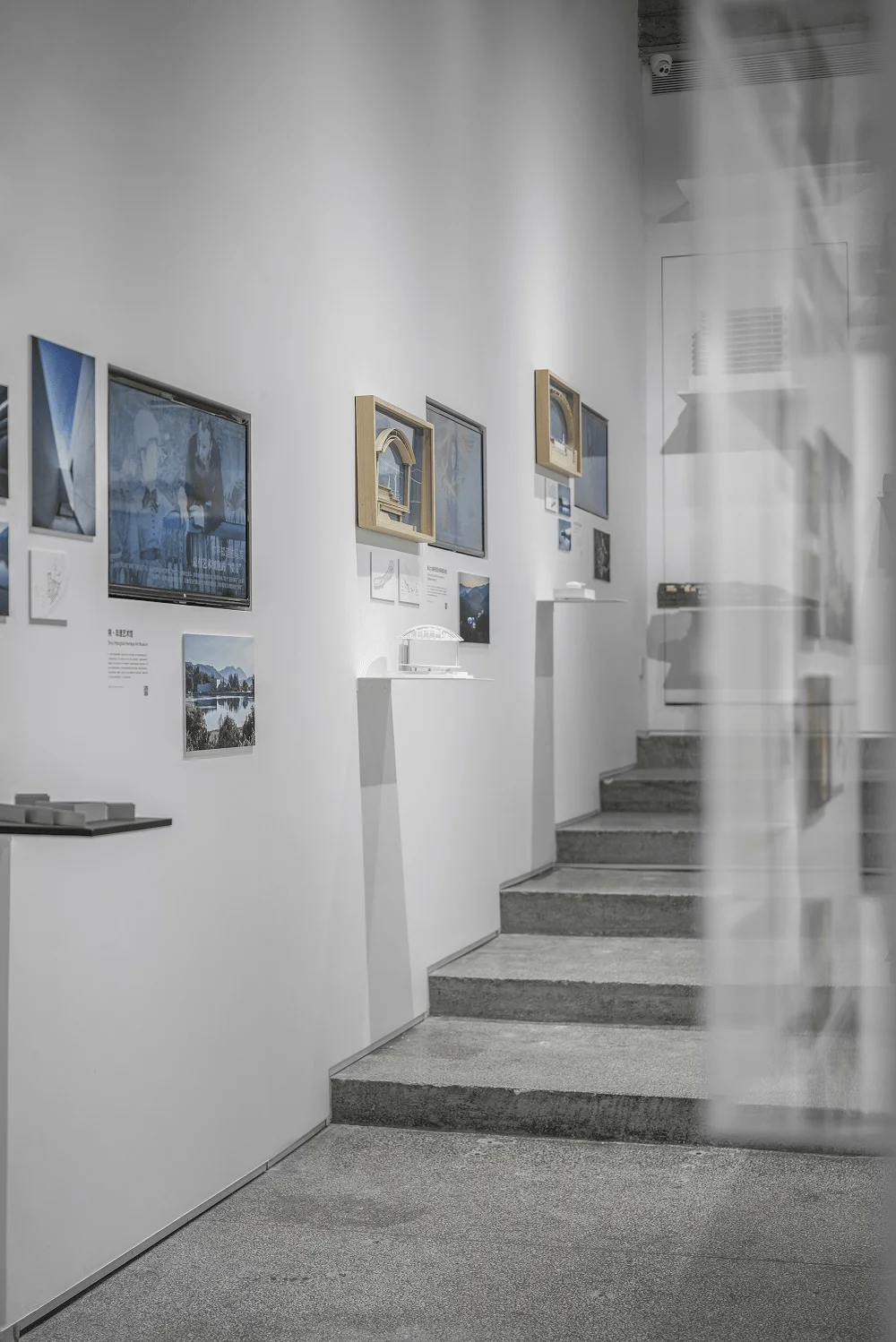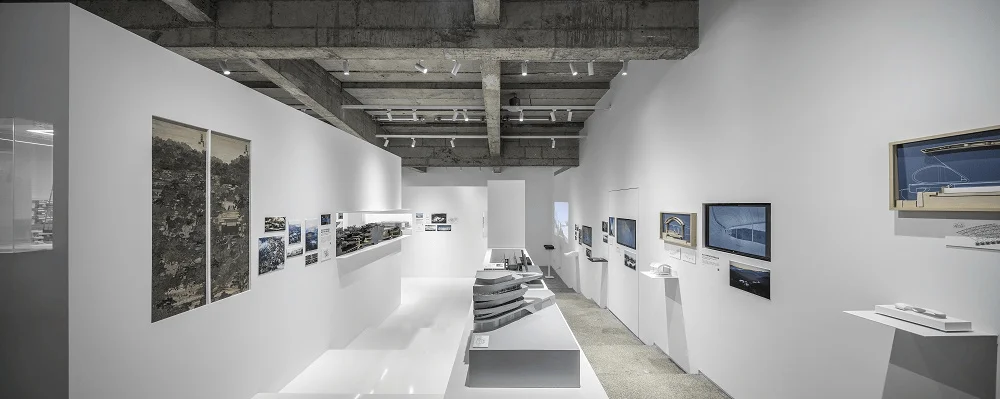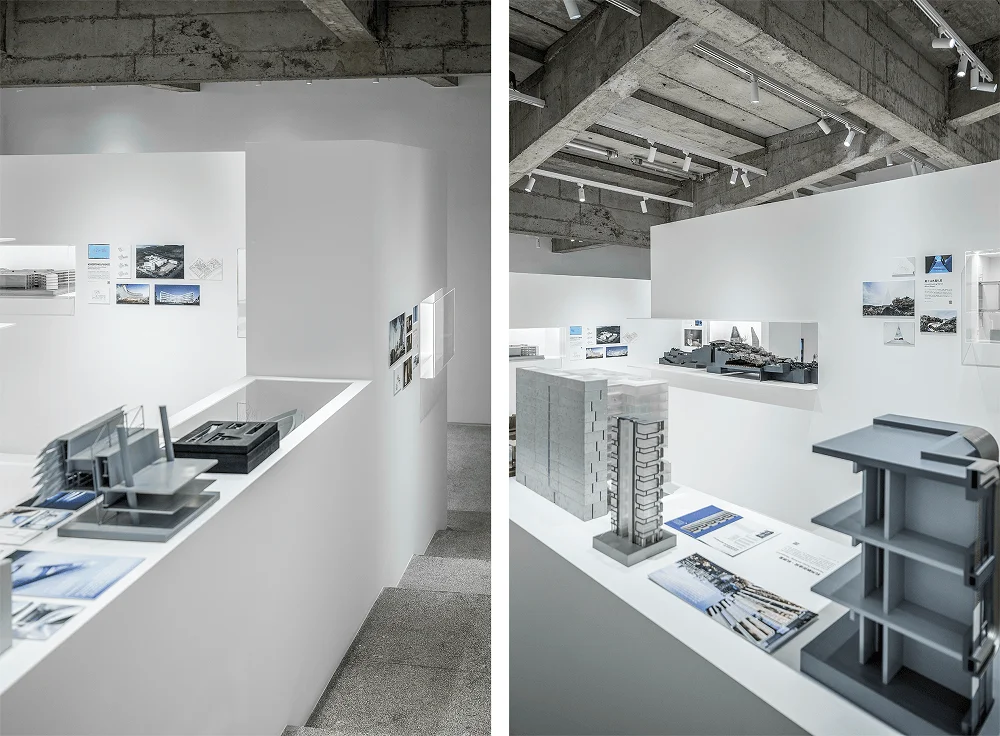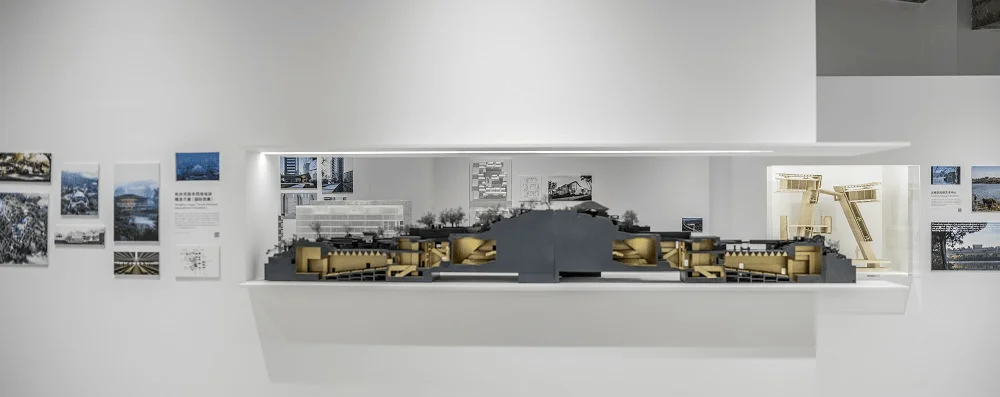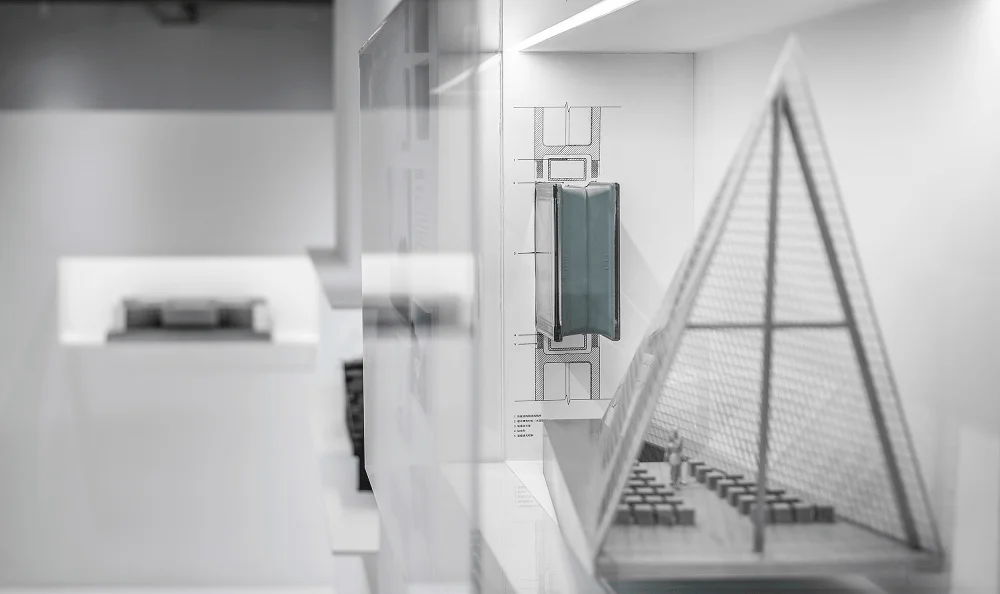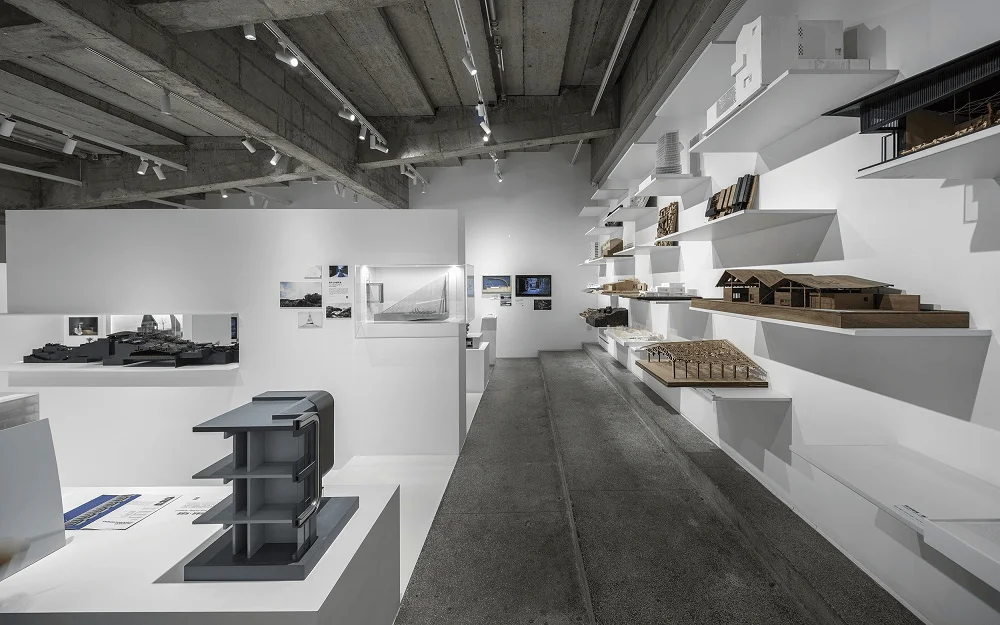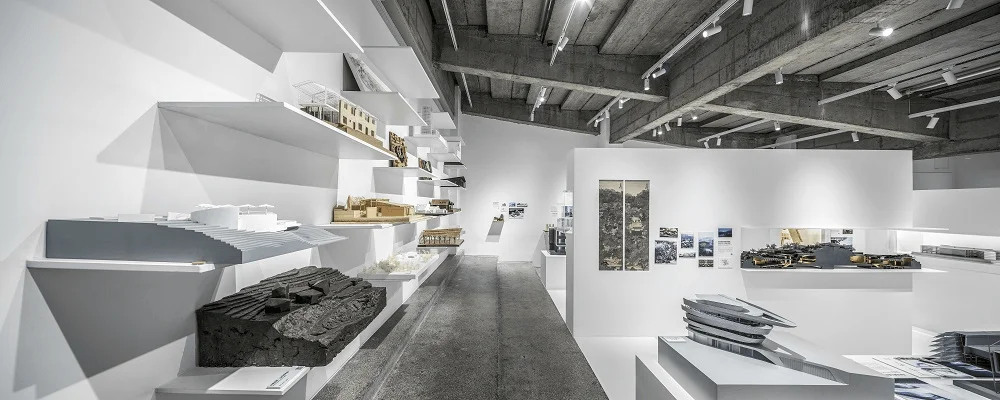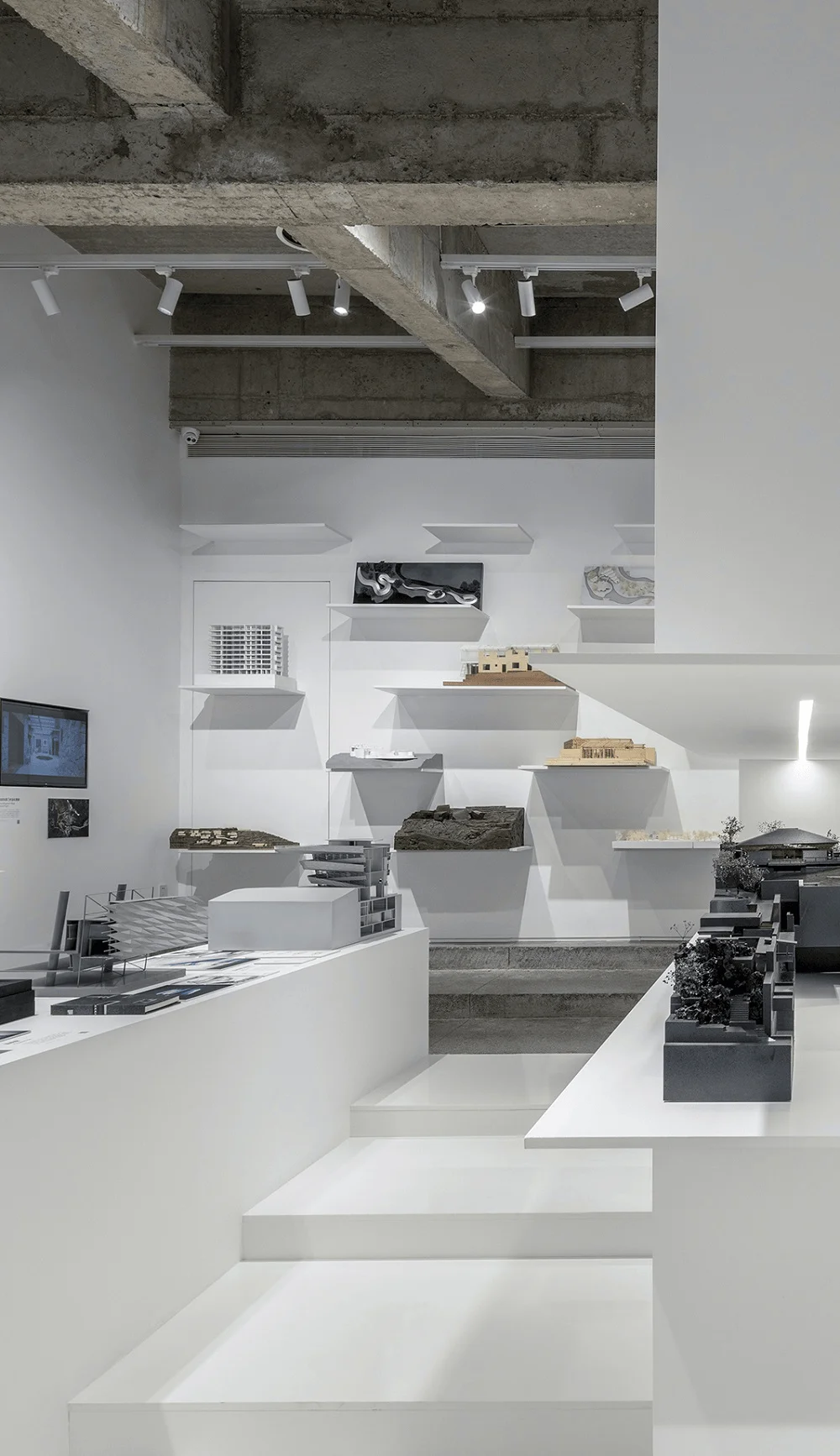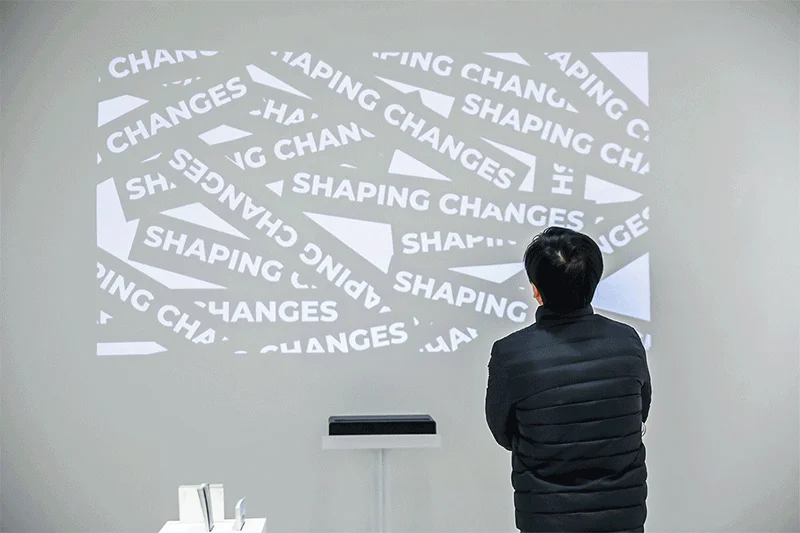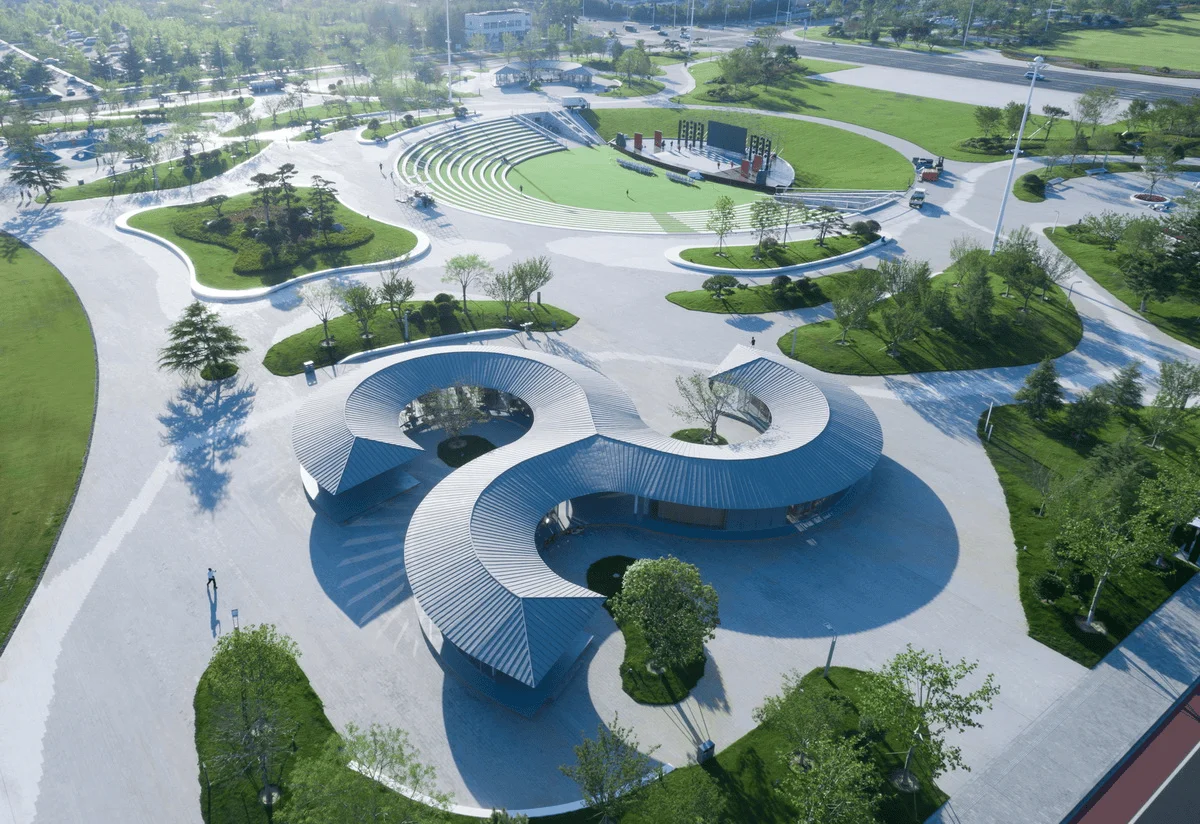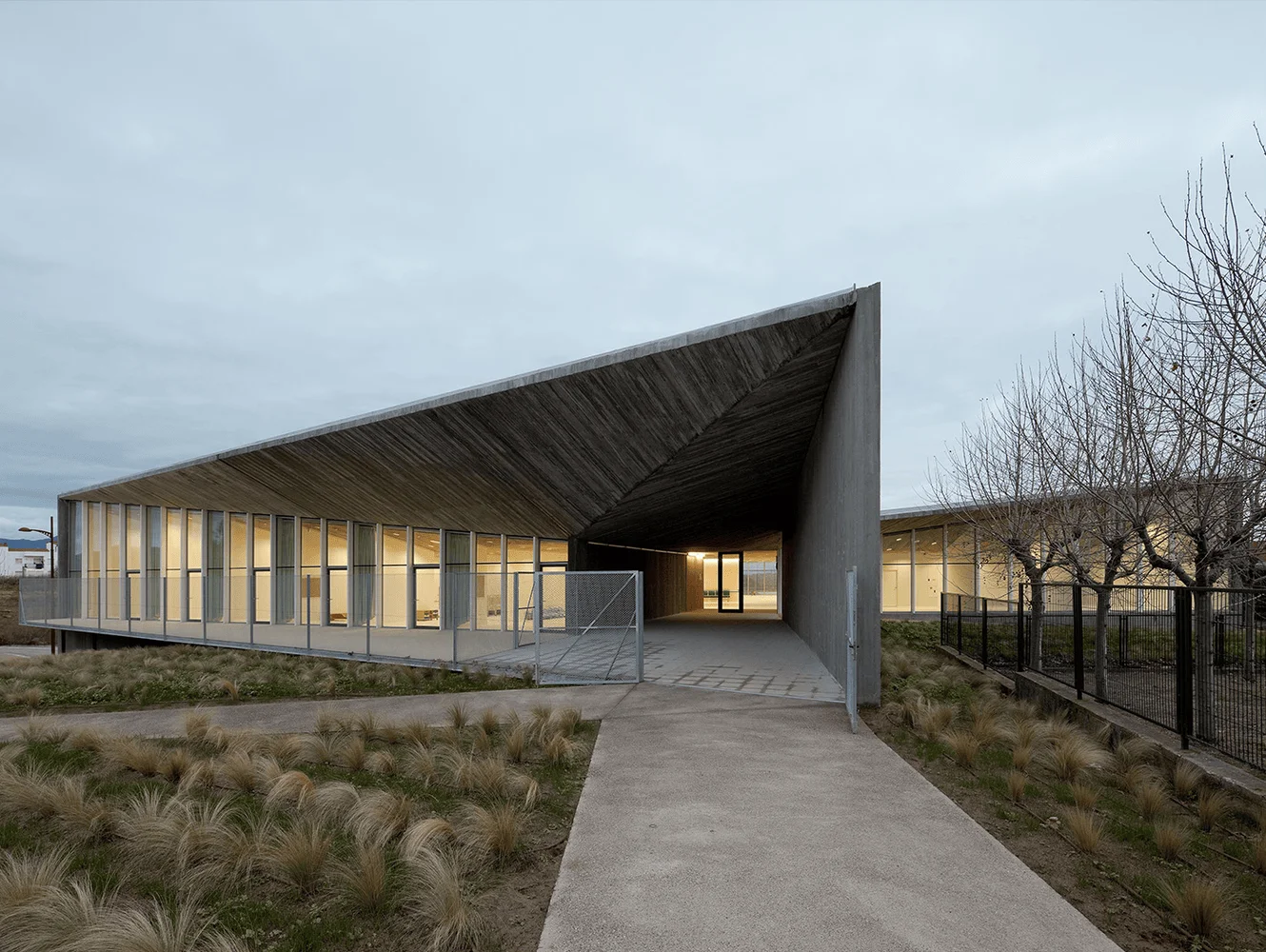The office space of line+, since moving to the old campus of Zhejiang Gongshang University in January 2018, has been in a constant state of growth. The office space is not only a container for work, but also a catalyst for communication. “Cold and friendly” is the keynote of the space, while “fluid and open” corresponds to the future’s ever-changing needs. For line+, the office space is never a finished product, but an organism with the ability to renew itself. At the end of 2020, coinciding with the firm’s third anniversary, we added an exhibition function to the stairwell space on the first floor, reviewing and displaying the firm’s projects since its inception, namely the “Space Empowerment: Meng Fanhao & Zhu Peidong Design Practice Exhibition”.
The space base is a typical small auditorium from the 1980s, with a stepped floor and ceiling. After removing the original ceiling, the concrete sloping beams and the rare prefabricated slabs were exposed, and like the gray terrazzo on the floor, these are all architectural symbols of the last century. We took advantage of the column width to set up an equipment cavity on one side of the space and cut out storage space at the rear. Complex equipment pipelines are hidden within, ensuring the purity of the space and highlighting the original memory retained by the ceiling and floor.
The original space has the standard plan of a stepped classroom, with the middle of the steps serving as the main entrance and the podium on the front side as a fire escape. After the function was adjusted to an exhibition hall, the number of people using it decreased drastically. We reversed the positions of the two entrances, ensuring that the entrance to the exhibition hall and the main entrance to the company are consistent, while also maintaining the integrity of the interface within the exhibition hall.
At the newly defined entrance, a bar counter module is set up to form a vestibule, dividing the original overall space into two parts: a showcase for external display and an internal area, increasing the sense of layering in the space.
Within the limited area of 120 square meters, we needed to change the previous unobstructed spatial state. A white block, as an integrated device, sits in the center of the space, becoming the visual focus. The exhibition hall space is thus divided into three parts: the front lobby, the central core exhibition area, and the side rear passage exhibition area.
The white block is cut into two band-shaped forms that interlock with each other, C+1, forming an elongated flow line. Exhibits are embedded in between in the form of transparent boxes, continuing the design approach of the building facade. The transparent boxes are arranged staggered on the inner and outer interfaces, maximizing the use of the exhibition wall. The boxes are made of acrylic and use a primitive mobile installation method, controlling both cost and construction difficulty, while also facilitating the updating of exhibits in the later stage.
The height of the white block needs to consider both the viewing modes for different types of architectural models and the height difference of the original steps. The front and rear sections use two different methods of wall display and tabletop display respectively, to ensure both the required enclosed independence of the lobby area and the transparent flow of the central exhibition area. The tabletop heights form 750mm and 1050mm desktop heights at different stopping positions, which correspond to the different viewing methods of tabletop placement and embedding.
Apart from transparent acrylic, white is the only color introduced into the space. By controlling the types and colors of materials, the newly constructed installations and the preserved base complement each other. All walls are painted with white latex paint, which is conducive to screen printing and later adjustments. The floor of the white block uses prefabricated white terrazzo, forming a whole with the wall.
The exhibition lobby is enclosed by three complete walls with exhibition introductions, projection displays, and project indexes, with a relatively open space for people to linger and stay.
The three white rectangular blocks of different lengths, widths, and heights are arranged in a staggered manner, naturally forming a flow line within the lobby. The different sizes and heights of the rectangular blocks correspond to the placement size and usage of exhibition brochures, postcards, and books. In addition to scattered placement, the three white blocks can also form a group as a whole, for concentrated display of content.
The index wall organizes the participating works into four practical scenarios. By extracting design characteristics, the projects appear in the form of logos composed of different shades of gray. The matrix formed by the logos of various works ultimately displays the breadth of the firm’s practice.
The Fei蔦集 model will participate in the Arsenale thematic exhibition of the Venice Biennale this year, and serves as the starting point for the exhibited projects in this retrospective exhibition, juxtaposed with the project index. Its model showcases the project’s material and craft strategies and the excavation of the value of traditional rural construction, reflecting the design’s main purpose of evoking homesickness and striving to restore villagers’ memories of their villages.
The passage exhibition areas on both sides correspond to the two practical scenarios of “In-situ Creation in Natural Fields” and “Organic Development at the Regional Scale” in this exhibition. Projects such as “Fishing Village Tea House” and “Tai’an East and West Gate Village Revitalization” are presented in a compositional relationship of small models, medium-sized screens, and graphics, forming a rhythmic variation on a continuous and complete wall. “Jiunv Peak Study” presents the project’s technical considerations behind its highly communicable visual image, its wide-ranging influence, and its activation of media attributes through partial structures and cross-section models.
The central exhibition area focuses on projects within “Boundary Reconstruction in Urban Space” and “Opportunity Exploration in High-Density Types.” Building models of different types become the focus of the exhibition, paired with embedded small screens and key graphics. Qiantang River Museum” uses a cross-section model to express the typological innovation of “all-weather public space” in this project, reflecting line+’s thinking on how to break down the inherent boundaries between urban public and private spaces, creating more fluid and open public spaces. China Energy Conservation Shanghai Headquarters” presents the entire design thinking process in video form on a small screen, showcasing the project’s use of natural forms and its creation of multi-dimensional connections and permeability. The horizontal openings in the central wall allow for interaction between the viewer and the models, and between the viewer and the models, allowing the line of sight to penetrate while creating interesting framing views. Inside the opening is a display of the concept design for the West Line Site of Lingyin Temple in Hangzhou (International Competition) project, with a large-scale overall cross-section model showcasing the site, function, and other constraints, the design’s fulfillment of the real spatial needs of modern temples, and its natural response to the thousand-year-old ancient temple, ultimately creating an ecological, open, public, and technologically intelligent modern temple cultural center.
The project’s materials and node drawings are cleverly integrated within the transparent boxes, showcasing the design process from different scales and levels of thinking.
The rear model wall is supported by cantilevered white metal plates that carry project working models from different stages, becoming the backdrop of the exhibition while naturally showcasing the firm’s project panorama.
In conclusion, architectural models, as miniature representations of real spaces, are ultimately presented through transparent cubes of different sizes, which are interspersed and integrated into the pure white block, and finally enveloped by the gray space rich in memories of the years. From entering the space, going through the installation, and finally viewing the architectural model, it is as if you are unwrapping layers of packaging to obtain the final gift. These models, representing line+’s architectural practice in different dimensions, will continue to bring new surprises to viewers as the firm develops.
Project Information:


